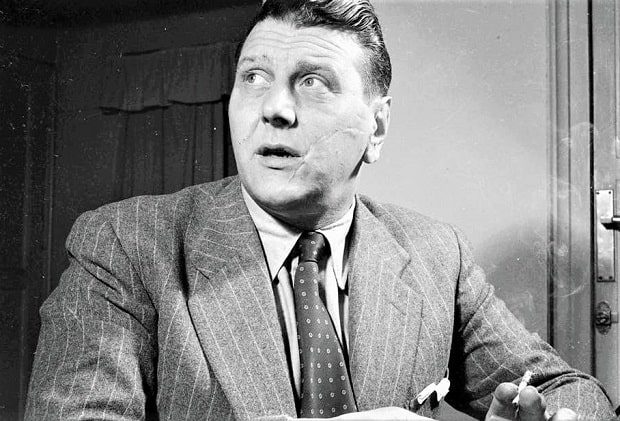
Otto Skorzeny was born into a middle-class family in Vienna, Austria, on June 12, 1908. Otto Skorzeny’s family has a long history of military service. As a student, he distinguished himself in scientific topics, and after graduating he enlisted at the University of Vienna as an engineering student. His great passion was fencing. He joined the University fencing team and during a match, he received the prominent scar on his cheek, known in German as a “Schmiss” which was then a coveted mark of bravery among German and Austrian youth.
In 1931, as Nazism was gaining popularity in Europe, Skorzeny joined the Austrian Nazi Party, filling the ranks of the local version of the paramilitary SA Brownshirts. Clever, ambitious and physically imposing at 6 ft 4 [1.93 Metres] he must have been a valued member. In the meanwhile, he had earned his degree and had started working as a civil engineer.
How Otto Skorzeny Became SS commander
Austria had become part of Germany with the 1938 Anschluss. So, when World War II broke out in 1939, Skorzeny applied to join the Wehrmacht. But his military career got off to a bumpy start when his application to join the Luftwaffe was denied. He was told he was too tall and too old at the age of 31.
Instead, he joined the SS and became an officer cadet in the Liebstandarte, Hitler’s bodyguard regiment. In 1940, Skorzeny was a second lieutenant in the Waffen-SS. His engineering skills proved useful when he designed special ramps to load tanks onto ships.
But he also proved his courage under fire during combat in Holland, France, and the Balkans. Here he was decorated after capturing a large Yugoslav force and was promoted to the first lieutenant. Skorzeny was then transferred to the Eastern Front after the launch of Operation Barbarossa in June 1941, with the 2nd SS Panzer Division “Das Reich”.
He was part of the unsuccessful siege of Moscow and in December 1942, now a captain received a head wound from a piece of shrapnel. Skorzeny was awarded the Iron Cross for bravery and then sent home to Vienna to recuperate. While there, he became fascinated by the idea of commando operations and read all the books he could find about them.
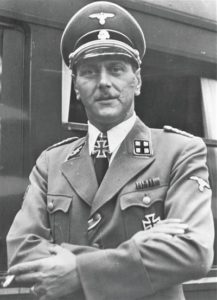
He then transformed those ideas into plans for unconventional warfare, which he submitted to higher headquarters. And they started to take notice. His concepts soon reached the desk of Ernst Kaltenbrunner, the new head of the Reich security services and successor to Reinhard Heydrich.
Skorzeny’s ideas were passed on to General Schellenberg, head of the SS foreign intelligence service. Skorzeny and Schellenberg met and the General was so impressed that he appointed him as commander of the newly created Waffen Sonderverband z.b.V. Friedenthal, an SS unit dedicated to special operations. His career as a commando leader had just begun.
Operations by Otto Skorzeny
1. Operation François
Otta Skorzeny and his unit launched into their first mission in the summer of 1943, Operation François. The plan was to organize the nomadic Qashqai people, in Iran, into an armed guerrilla force which could serve the German war effort. Skorzeny’s paratroopers were also assigned to disrupt the supply lines between the Allies and the Soviets and to turn the local population against the Allied presence.
Skorzeny parachuted into Northern Iran packed with gold and explosives. He intended to bribe the tribesmen elders and win their support for the mobilization of the entire people. The operation proved to be a failure: a fellow agent, Paul Ernst Fackenheim, made a remark that as soon as they were out of gold, the Persians sold them to the British.
2. Operation Oak
Skorzeny’s next mission would prove his most famous and spectacular success: Operation Oak, the rescue of Benito Mussolini, imprisoned after the Monarchist coup in July 1943. First Skorzeny had to find Mussolini. The ex-dictator was continually moved from one hiding place to another, but the Germans discovered him at a villa on the isle of La Maddalena, near Sardinia. Skorzeny then flew over in a Heinkel He-111 bomber to take aerial photos of the location, but the plane was shot down by Allied fighters and crashed into the sea. Skorzeny and his men were rescued by an Italian warship.
Mussolini has moved again and the chase continued. Finally, Skorzeny tracked him down to the Campo Imperatore Hotel, a remote and fortified resort on the Gran Sasso mountain in central Italy. The hotel was accessible only by funicular. He, Luftwaffe General Kurt Student and Major Otto-Harald Mors, a paratrooper battalion commander, came up with a workable plan.
Skorzeny assembled a team of 107 commandos who would be landed in gliders. On the 12th of September 1943, the gliders approached the hotel. Skorzeny realized too late that what he thought to be a patch of grass was a rocky incline. His glider almost crashed, but he made it out in one piece.
Twelve minutes later, Skorzeny had found Mussolini, and not one person had been killed. The Fuhrer, delighted with Skorzeny, awarded him the Knights Cross. As a result, he became Hitler’s favorite commando and was dubbed “the most dangerous man in Europe” by the Allies although propaganda chief Dr. Goebbels may have been the first to give him that title.
Propaganda coverage of the event, however, hid the fact that most of the planning and execution had to be credited to Skorzeny’s associates, General Student and Major Mors. Skorzeny stole their thunder by making sure he would be the one escorting Mussolini to the get-away plane in full view of the cameras.
Skorzeny though should be recognized with the stroke of genius that ensured the raid was bloodless. He had secured the cooperation of General Soleti of the Carabinieri, the military police. Solti was actually the first one to approach the Hotel and ordered the heavily armed military policemen to stand down.
It should be noted that footage and photos of the event show many of the Italian guards posing with big smiles by Mussolini and Skorzeny, hinting at their true loyalties. Based on testimonies from one of the guards, Mussolini seemed to be the least happy to have been rescued.
3. Operation Long Jump
The next mission for Otto Skorzeny was Operation Long Jump, November 1943. Its ambitious goal was to kill or kidnap the Allies’ “Big Three” leaders – Stalin, Churchill, Roosevelt—at their strategic conference in Tehran, Iran. The first group of six German operatives landed in Qom, before proceeding to Teheran on camelback.
Skorzeny was supposed to join the group with the second team of assassins. Unfortunately for them, a few months earlier, the Operation’s planner SS officer von Ortel had just made friends with a Wehrmacht Lieutenant in a bar in Copenhagen. Blind drunk, Ortel had spilled the beans on Long Jump. That lieutenant, well he was a Soviet intelligence officer in disguise.
Roosevelt and Churchill were alerted to the plot and were kept safe at the Soviet Embassy. The NKVD then seized the six German commandos and forced them to radio to Skorzeny’s team that the operation had failed. To give the full picture, some sources claim that this plot never existed. It was just a clever ruse of Stalin and/or the NKVD to force the Western leaders to stay inside the Soviet Embassy, where their conversations could be easily bugged.
4. Operation Knight’s Leap
The next high level hit commissioned to Otto Skorzeny was the capture of Tito, Operation Knight’s Leap. Also, in this case, Skorzeny and his commandos attacked by gliders, while conventional forces engaged Tito’s partisans around his mountain helicopters. Did I say helicopters? Sorry, I meant headquarters. In any case, the partisans’ resistance was fierce, stalling the pincer movement and allowing Tito to escape.
Skorzeny would finally have time to shine after the 20th of July 1944, following the attempted bombing on Hitler. In his memoir, he claimed he played an integral part in restoring order to Berlin, where the conspirators had initiated the plan ‘Valkyrie’ to topple the regime.
Otto Skorzeny infiltrated the conspirators’ base of operations and had the “Valkyrie” order rescinded. This was an order intended to quell a possible coup but had been cleverly exploited by the conspirators to trick German troops into arresting loyal Nazi officials. Skorzeny’s actions contributed to dissipate confusion, restore communications to Fuhrer Headquarters and preventing a possible civil war between German troops. Skorzeny took charge of Wehrmacht administration until normalcy returned. Again, Hitler was delighted.
5. Operation Panzerfaust
In October 1944 he dispatched him to Budapest to lead Operation Panzerfaust, aka Operation Mickey Mouse. The Fuehrer was not pleased with Hungarian leader Admiral Horthy, an uneasy ally against the Soviet Union, who was actually pro-American and had always refused to deport the Jewish population.
The Germans got wind that he was negotiating with the allies and Skorzeny was sent to exact punishment. Skorzeny and his commandos stormed the presidential palace, seized the Admiral’s son, rolled him into a carpet, and kidnapped him. Horthy was forced to negotiate, and eventually to stand down. His leadership was replaced by a puppet government under the Arrow Cross party, staunchly anti-Semitic. During the following 56 days, an estimated 320,000 Hungarian Jews were sent to their deaths in the gas chambers. Another 100,000 starved or died of the disease.
6. Operation Greif
In December of 1944, Otto Skorzeny launched his most infamous mission: Operation Greif, or “Griffin“. The goal was to capture key bridges over the Meuse River during the Battle of the Bulge, the last German offensive in the West. Skorzeny’s plan was ingenious: he selected commandos who were fluent in English, dressed them in American uniforms and sent them behind enemy lines in Belgium to spread panic and confusion.
Skorzeny’s men cut communication wires, issued fake orders, and turned around road signs. The Americans grew paranoid: some GIs fired on each other, while others grilled their mates about American popular culture to identify if they were German agents.
If you were American but did not care about baseball nor movie stars, you could get arrested! At one point, Field Marshal Bernard Montgomery refused to show his ID and had his car tires shot out. He was then dragged into a barn and restrained until his identity could be confirmed.
Otto Skorzeny spread the false rumor among his men that the real aim was the assassination of General Eisenhower, headquartered in Paris. German agents captured by the Americans confessed to this plot. As a result, Eisenhower was put under virtual arrest for his own protection. Griffin eventually failed and many Germans were easily identified and shot as spies.
7. Operation Werewolf SS
As the Reich crumbled, Skorzeny’s final involvement was with Operation Werewolf. This was a resistance movement, mostly composed of Hitler Youth members, trained in guerrilla tactics to oppose an Allied occupation. It actually was a desperate propaganda ruse by Goebbels to raise morale.
But Skorzeny hijacked the plan and used this small force to aid the escaping Nazi high officials. The Soviet NKVD, probably overestimating the size and importance of Werewolf, killed roughly 5,000 boys, aged 15 to 17, for suspected guerrilla activity. A few days after Hitler’s suicide, Skorzeny handed himself over to the Americans.
He was a highly decorated, well-respected military professional but his directive for his men to wear American uniforms got him in trouble. This was considered a war crime and was put on trial in 1947. Luckily for him, he escaped execution when British SOE operatives confirmed they wore German uniforms during the war. But he had to answer from other charges.
Before he could be prosecuted, though, Skorzeny escaped from the POW camp with the help of two ex-SS men, dressed as American military police. He later claimed this was a plan of the OSS, the CIA’s predecessor: his freedom, in return for his services. Was this true?
The Most Dangerous Man in Madrid
Otto Skorzeny first hid in Bavaria, then Salzburg and finally Spain, where he cooperated with Francisco Franco’s military and intelligence services. He was “de-Nazified” in absentia by a German court in 1952 but was still a “person of interest” for the famed Austrian Nazi hunter, Simon Wiesenthal. In any case, he could lead an open life. He had a young wife, Ilse von Finckenstein.
He had several legitimate activities: an engineering firm, an import-export business, and a mercenary security company. But he apparently had time for other endeavors. He founded a Neo-Nazi group called CEDADE, the Spanish Circle of Friends of Europe and is rumored to have smuggled ex-Nazis to South America.
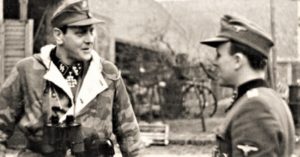
Particularly in Argentina, where he served briefly as a military advisor to Juan Perón. Most notably he was bodyguard to Evita. There are even rumors of an affair between the two. In the late 50s, he became fixated with gaining entry to the UK. This may be the reason why in 1959 Otto Skorzeny bought a farm in County Kildare, Ireland.
He was granted temporary visas to stay in Ireland, but state records mention his indignation at the continual refusal of the British authorities to allow him an entry in the UK. Newspaper reports in the 1960s give another version: his farm in Ireland was a place where fleeing Nazis could hide, but no evidence was found to substantiate this claim. Maybe he just liked the Guinness?
Alleged Recruitment by The Mossad
And now for something truly puzzling. As an escaped former SS, who had indirectly contributed to the deportation of the Hungarian Jews, Skorzeny knew very well that his name was top in the list of Nazi hunter Simon Wiesenthal. And so, he was the first one to be surprised when agents of the Mossad, Israeli intelligence, came to recruit him Early in 1962.
Otto Skorzeny was having some drinks at a bar in Madrid with his wife Ilse. The two befriended another younger couple of German tourists, who had just been robbed and were looking for some help. The two couples went on drinking and, apparently, flirting, until the Skorzenys invited them to their villa.
Just when things seemed to, well kick-off well, they did kick-off, but in another way. Skorzeny pulled a gun on the couple: “I know who you are, and I know why you are here. You are Mossad, and you’ve come here to kill me!” The man replied, “If we had come to kill you, you would have been dead weeks ago.”
The two operatives were there to offer Skorzeny a deal: they needed his services and would pay handsomely. Skorzeny was not interested in money. What he wanted, was to be removed from Wiesenthal’s list. The Mossad agents agreed. Skorzeny was flown to Tel Aviv, where he met Mossad agent Joe Ranaan. He was also Viennese, but as a Jew, he had lost all his family in the camps.
Ranaan took the ex-SS to the Yad Vashem, the Holocaust Museum, and observed that he appeared respectful. Skorzeny’s mission was to thwart Egypt’s military rocket program, led by Heinz Krug, a German scientist formerly associated with Werner Von Braun. The Austrian commando was shown a letter from Wiesenthal, accepting the removal of his name from the list of Nazi criminals.
In truth, Wiesenthal had refused. The letter was a Mossad forgery. Skorzeny kept his promise and he delivered big time. He flew to Egypt and identified all German scientists working for the program. He then unmasked several companies around Europe that were secretly selling rocket components to the Egyptians.
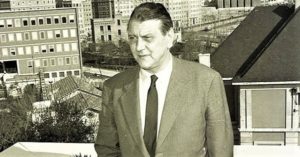
He even carried out a campaign of intimidation against the scientists and mailed explosive packages prepared by the Mossad, killing five Egyptian technicians. One day in 1962, while in Madrid, Skorzeny received a phone call. It was Heinz Krug, the lead scientist of the program. Krug was dead scared and was seeking Skorzeny’s help and protection.
Skorzeny arranged to meet him in Munich. As he drove him out of town in a white Mercedes he reassured him: he had already hired some bodyguards and they were driving to meet them. As they stepped out of the car and into the woods, Skorzeny shot Krug. Three Mossad agents then took care of the body by dissolving it in acid. Skorzeny’s job was done. He had not made a penny out of it. He didn’t know it but was still on the Wiesenthal list. But at least he would be spared by the Mossad.
The Most Dangerous Man in an FOIA Search Engine
Another intelligence service famously associated with Otto Skorzeny was the CIA. We wanted to verify this claim directly at the source and so we did some rummaging in the CIA’s own Freedom Of Information Act (FOIA) search engine. A brief memo states that in 1961 Skorzeny had a plan to kidnap Fidel Castro. This plan had the approval of CIA Director Allen Dulles but had been vetoed by JFK.
There is a catch: the memo quotes an interview released by Skorzeny to a Peruvian newspaper in 1966. Knowing the man’s knack for self-publicity, can we truly believe this? So, we dug deeper. On the 26th of January 1951, a report was sent to the Secretary of State from Germany by John J. McCloy, American High Commissioner for Occupied Germany.
McCloy reports that Chancellor Adenauer was worried about rumors of Skorzeny training the Spanish military with US covert support. McCloy was not aware of this scheme and admitted it was worrying. The CIA knew very well that Skorzeny was in Spain. They learned this from a letter dated 21st of September 1949, sent by FBI Director J. Edgar Hoover.
Skorzeny had been sighted “working in Spain with a group of Nazis with the blessings of Franco”. In April 1951, the CIA was keeping tabs on Skorzeny’s activities in Madrid. In particular, they wrote about internal feuding amongst former Nazi officers, with concerns for it to go public.
The memo reads: “View possibility unfavorable publicity break as result Skorzeny’s maneuvering. Consider important we clarify our interests and any US connections fully. Can you explain claims Skorzeny connected with or supported by US Colonel Thompson or Stimpson? View categorical denial” The agent asks the question: is possibly the CIC, Counter-Intelligence Corps behind Skorzeny? The CIC was a Cold War-era secret service within the US Army ranks.
Moving to the 1960s, the CIA kept a close eye on Skorzeny’s relationship to ‘UPHILL’ which appears to be a code name for an organization. One report states that the Chief of Uphill had warned that US support for Skorzeny would be a source of embarrassment for the White House.
This is similar to Adenauer’s warning. The picture that emerges so far is that some US agency, possibly the CIC, had some form of contact with him, and German authorities had warned the US to be careful about it. But what of Skorzeny’s relationship with other powers? There is another document that complicates matters even more.
The agent signs himself as ‘Heckenschuetze’ – ‘sniper’. We’ll post the link in the description, so you can read it in full, but here is the gist of it. At the end of 1943, sensing that the war would be lost, Martin Bormann, Hitler’s secretary, created a secret organization called “HACKE” It was so exclusive to count only 35 members. And so secretive that even Himmler was unaware of it.
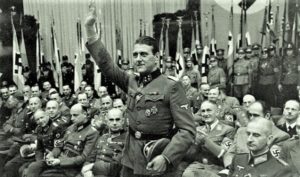
The purpose of Hacke was to guarantee the survival of Nazi officials in case of defeat. To do so, Hacke racked up half a billion dollars from concentration camp victims and created hideouts in Spain, Portugal, Italy, Japan, and Argentina. But the twist is that the Soviet intelligence had infiltrated this network, apparently by blackmailing Bormann, lest they revealed the existence of Hacke to Himmler.
Hacke remained active after the war, but here comes another twist: “One of the dark and dangerous KGB figures in Hacke is the famous SS Colonel Skorzeny who presently lives in Madrid and also works for the Spanish IS (intelligence service). Otto Skorzeny was under active development by Abakumow as early as 1942 Skorzeny was finally recruited as a collaborator of Abakumow in the middle of 1944” Abakumow being a Soviet intelligence General.
He planned to exploit ex-Nazi officials and agents settled in the Americas. The author of the document to be fair states that it is unclear whether Abakumow succeeded in his plans, and looks for other clues to confirm Skorzeny’s allegiance to the KGB. One of these clues is that Skorzeny was very close to another ex-Nazi operative, Karl Rudl.
The two had been tasked with a secret mission by the Vatican to smuggle a Hungarian Cardinal out of prison. Rudl was actually an agent of Abakumow, who had intentions to hijack the prison escape to have the Cardinal shot. Rudl smelled a rat – he was probably going to get shot, too, while Abakumow would leave Otto Skorzeny alive. And so, he aborted the operation.
To recap, from the 1940s to the 1960s Otto Skorzeny was A commando for the Nazi security services A possible double-agent for the Soviets A member of the neo-Nazi ring “HACKE” An agent of Franco’s intelligence A hitman for the Mossad A possible informant to the US CIC An operative for the Vatican As you can see, our initial question ‘did Skorzeny work for the CIA?’ seems irrelevant now. The answer is probably, no. If anything, his calendar was too full to fit them in.
Death of Otto Skorzeny
In his later years, Otto Skorzeny fell ill from lung cancer. On July 5, 1975, he died in Madrid at the age of 67. He had two funerals, one in Madrid, and the other at his family plot in Vienna. At both, he received full Nazi honors, with veterans giving him the Nazi salute and singing some of Hitler’s favorite songs.
Among those present, one man stood apart. He did not join in with the Nazi nostalgic paraphernalia but offered a silent salute to a fellow secret agent and fighter. Someone he had grown up hating but had learned to respect. That man was Mossad agent Joe Ranaan.